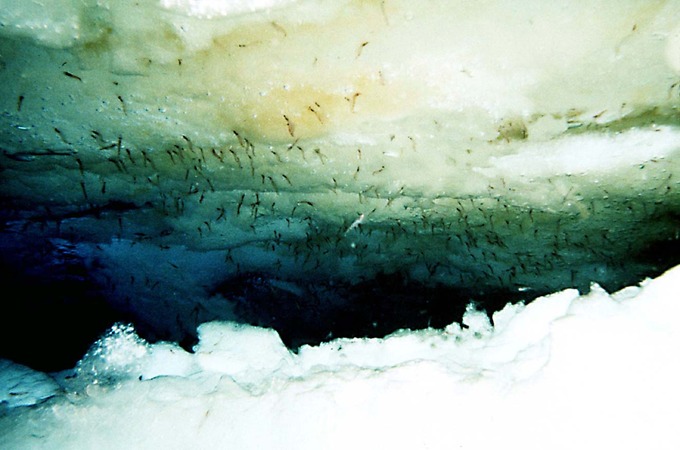1.2D: Environmental Diversity of Microbes
- Page ID
- 8774
- Summarize how microbial diversity contributes to microbial occupation of diverse geographical niches.
The microbial world encompasses most of the phylogenetic diversity on Earth, as all Bacteria, all Archaea, and most lineages of the Eukarya are microorganisms. Microbes live in every kind of habitat (terrestrial, aquatic, atmospheric, or living host) and their presence invariably affects the environment in which they grow. Their diversity enables them to thrive in extremely cold or extremely hot environments. Their diversity also makes them tolerant of many other conditions, such as limited water availability, high salt content, and low oxygen levels.


Not every microbe can survive in all habitats, though. Each type of microbe has evolved to live within a narrow range of conditions. Although the vast majority of microbial diversity remains undetermined, it is globally understood that the effects of microorganisms on their environment can be beneficial. The beneficial effects of microbes derive from their metabolic activities in the environment, their associations with plants and animals, and from their use in food production and biotechnological processes.
In turn, the environment and the recent temperature anomalies play a crucial role in driving changes to the microbial communities. For instance, the assemblage of microbes that exists on the surface of seawater is thought to have undergone tremendous change with respect to composition, abundance, diversity, and virulence as a result of climate-driving sea surface warming.
For microbiologists, it is critical to study microbial adaptation to different environments and their function in those environments to understand global microbial diversity, ecology, and evolution. They rely on specific physical and chemical factors such as measuring temperature, pH, and salinity within a certain geography to formulate a comparison among microbial communities and the environment different species can tolerate. Researchers collect samples from geographical areas with different environmental conditions and between seasons to determine how dispersal patterns shape microbial communities and understand why organisms live where they do. As such, microbial communities from coastal and open oceans, polar regions, rivers, lakes, soils, atmosphere, and the human body can be tested. These samplings create a starting point to understand how the abundance and composition of microbial communities correlate with climatic perturbations, interact to effect ecosystem processes, and influence human health. Interfering with natural microbial biomass disrupts the balance of nature and the ecosystem and leads to loss of biodiversity.
Key Points
- Different microbial species thrive under different environmental conditions.
- Microbial communities occupy aquatic and terrestrial habitats and constitute the majority of biodiversity on Earth.
- Microbial diversities sustain the ecosystem in which they grow.
Key Terms
- biodiversity: The diversity (number and variety of species) of plant and animal life within a region.
- biomass: The total mass of all living things within a specific area or habitat.
LICENSES AND ATTRIBUTIONS
CC LICENSED CONTENT, SPECIFIC ATTRIBUTION
- Microorganisms. Provided by: Wikipedia. Located at: http://en.Wikipedia.org/wiki/Microorganisms. License: CC BY-SA: Attribution-ShareAlike
- Gram stain. Provided by: Wikipedia. Located at: en.Wikipedia.org/wiki/Gram%20stain. License: CC BY-SA: Attribution-ShareAlike
- peptidoglycan. Provided by: Wiktionary. Located at: en.wiktionary.org/wiki/peptidoglycan. License: CC BY-SA: Attribution-ShareAlike
- Life Six Kingdoms. Provided by: Wikimedia. Located at: commons.wikimedia.org/wiki/File:Life_Six_Kingdoms.png. License: CC BY-SA: Attribution-ShareAlike
- Gram stain 01. Provided by: Wikipedia. Located at: en.Wikipedia.org/wiki/File:Gram_stain_01.jpg. License: CC BY-SA: Attribution-ShareAlike
- Taxonomy. Provided by: Wikipedia. Located at: en.Wikipedia.org/wiki/Taxonomy. License: CC BY-SA: Attribution-ShareAlike
- Binomial nomenclature. Provided by: Wikipedia. Located at: en.Wikipedia.org/wiki/Binomial_nomenclature. License: CC BY-SA: Attribution-ShareAlike
- DNA fingerprinting. Provided by: Wikipedia. Located at: en.Wikipedia.org/wiki/DNA%20fingerprinting. License: CC BY-SA: Attribution-ShareAlike
- Life Six Kingdoms. Provided by: Wikimedia. Located at: commons.wikimedia.org/wiki/File:Life_Six_Kingdoms.png. License: CC BY-SA: Attribution-ShareAlike
- Gram stain 01. Provided by: Wikipedia. Located at: en.Wikipedia.org/wiki/File:Gram_stain_01.jpg. License: CC BY-SA: Attribution-ShareAlike
- data-attribution-url=upload.wikimedia.org/wikipedi...Coli_NIAID.jpg. Provided by: Wikimedia. License: Public Domain: No Known Copyright
- Panspermia. Provided by: Wikipedia. Located at: en.Wikipedia.org/wiki/Panspermia. License: CC BY-SA: Attribution-ShareAlike
- Endosymbiont. Provided by: Wikipedia. Located at: en.Wikipedia.org/wiki/Endosymbiont%23Endosymbiosis_theory_and_mitochondria_and_chloroplasts. License: CC BY-SA: Attribution-ShareAlike
- Archaea. Provided by: Wikipedia. Located at: en.Wikipedia.org/wiki/Archaea. License: CC BY-SA: Attribution-ShareAlike
- panspermia. Provided by: Wiktionary. Located at: en.wiktionary.org/wiki/panspermia. License: CC BY-SA: Attribution-ShareAlike
- endosymbiosis. Provided by: Wiktionary. Located at: en.wiktionary.org/wiki/endosymbiosis. License: CC BY-SA: Attribution-ShareAlike
- Life Six Kingdoms. Provided by: Wikimedia. Located at: commons.wikimedia.org/wiki/File:Life_Six_Kingdoms.png. License: CC BY-SA: Attribution-ShareAlike
- Gram stain 01. Provided by: Wikipedia. Located at: en.Wikipedia.org/wiki/File:Gram_stain_01.jpg. License: CC BY-SA: Attribution-ShareAlike
- data-attribution-url=upload.wikimedia.org/wikipedi...Coli_NIAID.jpg. Provided by: Wikimedia. License: Public Domain: No Known Copyright
- Stromatolites. Provided by: Wikipedia. Located at: en.Wikipedia.org/wiki/File:Stromatolites.jpg. License: CC BY-SA: Attribution-ShareAlike
- Microecology. Provided by: Wikipedia. Located at: en.Wikipedia.org/wiki/Microecology. License: CC BY-SA: Attribution-ShareAlike
- biodiversity. Provided by: Wiktionary. Located at: en.wiktionary.org/wiki/biodiversity. License: CC BY-SA: Attribution-ShareAlike
- biomass. Provided by: Wiktionary. Located at: en.wiktionary.org/wiki/biomass. License: CC BY-SA: Attribution-ShareAlike
- Life Six Kingdoms. Provided by: Wikimedia. Located at: commons.wikimedia.org/wiki/File:Life_Six_Kingdoms.png. License: CC BY-SA: Attribution-ShareAlike
- Gram stain 01. Provided by: Wikipedia. Located at: en.Wikipedia.org/wiki/File:Gram_stain_01.jpg. License: CC BY-SA: Attribution-ShareAlike
- data-attribution-url=upload.wikimedia.org/wikipedi...Coli_NIAID.jpg. Provided by: Wikimedia. License: Public Domain: No Known Copyright
- Stromatolites. Provided by: Wikipedia. Located at: en.Wikipedia.org/wiki/File:Stromatolites.jpg. License: CC BY-SA: Attribution-ShareAlike
- Krillicekils. Provided by: Wikipedia. Located at: en.Wikipedia.org/wiki/File:Krillicekils.jpg. License: CC BY-SA: Attribution-ShareAlike
- Algal mats on hot pool, Orakei Korako 1. Provided by: Wikipedia. Located at: en.Wikipedia.org/wiki/File:Algal_mats_on_hot_pool,_Orakei_Korako_1.jpg. License: CC BY-SA: Attribution-ShareAlike


